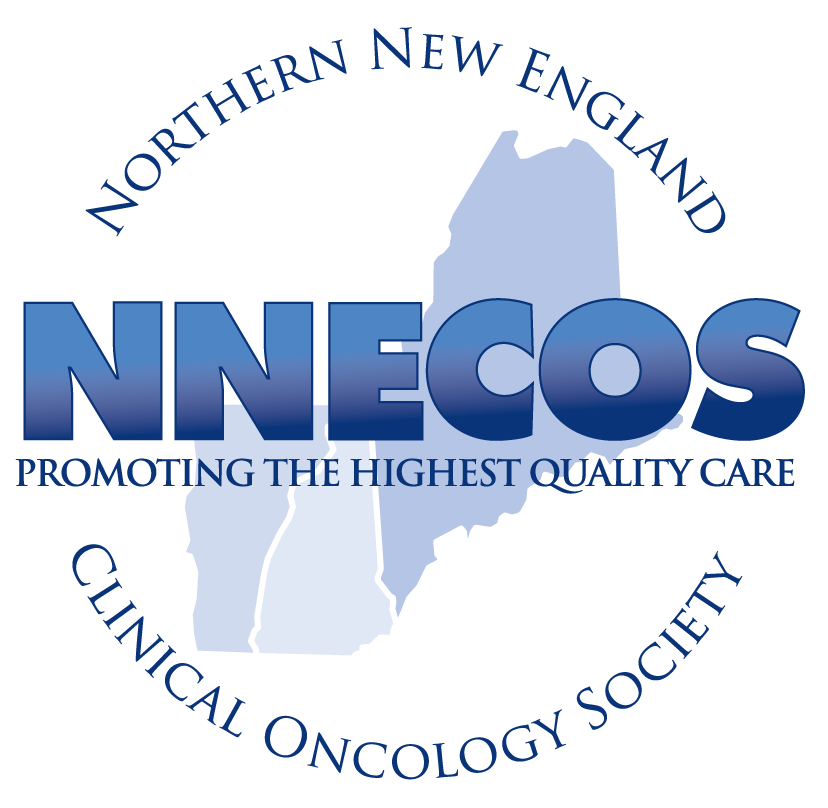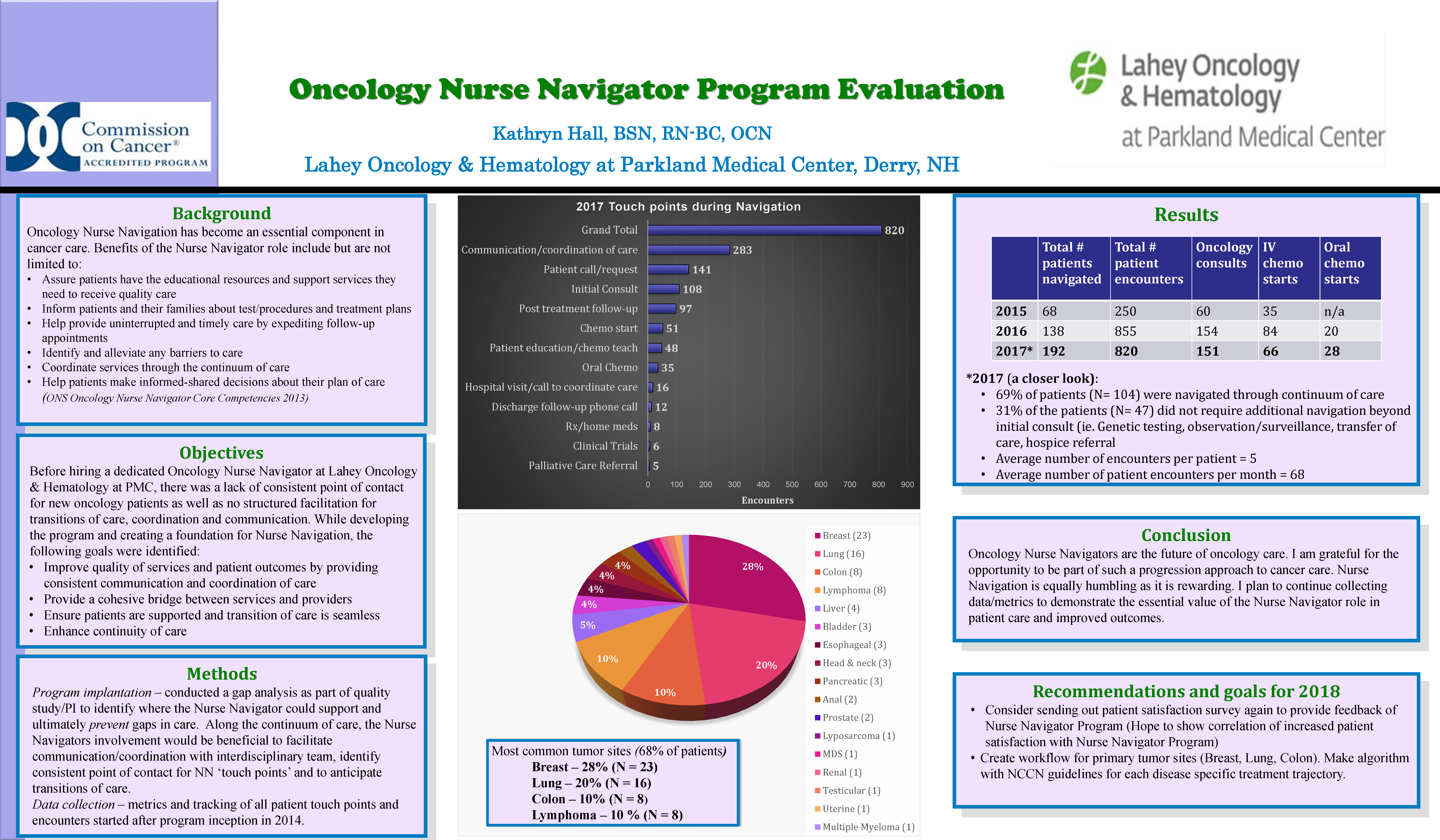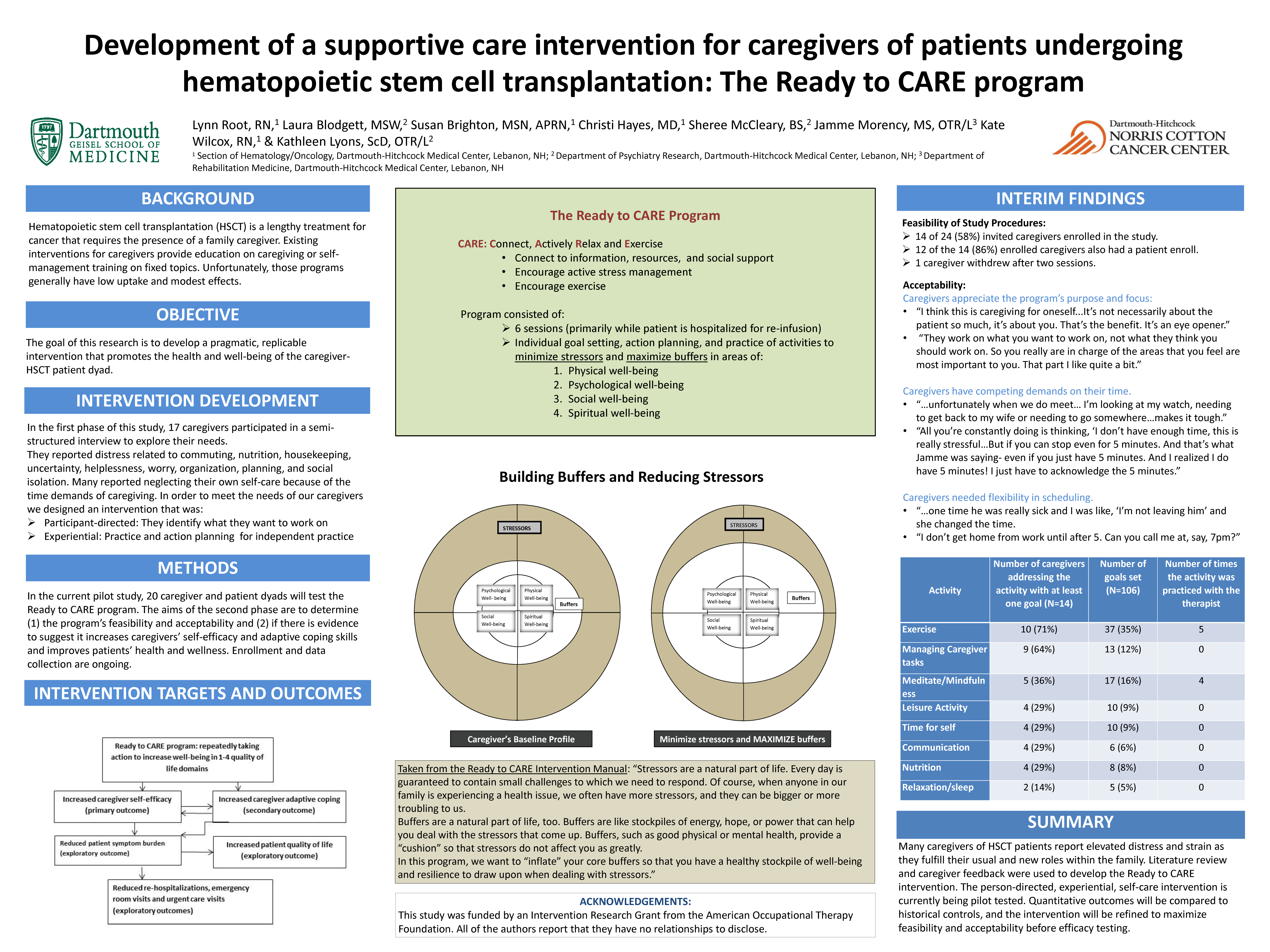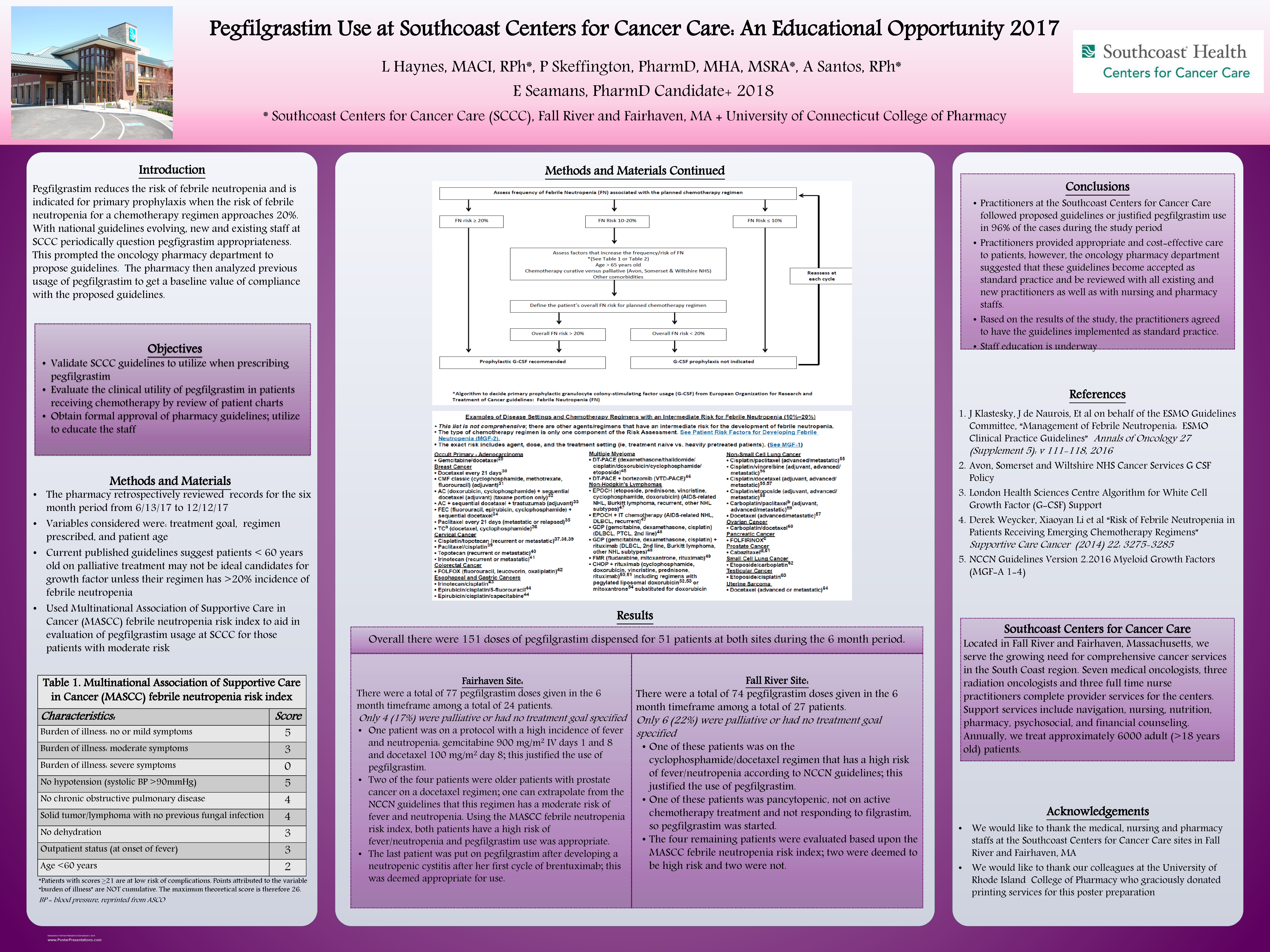2018 Spring Meeting Accepted Abstracts
Congratulations to the Poster Award Winners!

We will be adding additional PDFs of the posters presented at the 2018 Spring Meeting on Saturday, March 24th. Please check back for more posters soon!
Social Media usage among healthcare providers in the northern New England cancer community
Bhavina Batukbhai MD (1), Lukas Emery DO (2), Nayan Agarwal (3), Frederick Lansigan MD (4)
(1) Dartmouth-Hitchcock Medical Center; (2) Department of Internal Medicine, Dartmouth-Hitchcock Medical Center; (3) Gielsel school of Medicine. Dartmouth College; (4) Department of Hematology-Oncology, Dartmouth-Hitchcock Medical Center
Background: In the last decade, social media(SM) has paved its way into the healthcare industry and have changed how patients experience care. We aim to evaluate the usage of SM among healthcare providers (HPs) in the largely rural northern New England (NNE) cancer community.
Methods: We surveyed HPs using a questionnaire measuring access, usage, and influence of SM. Surveys were solicited via email and advertising through the NNECOS organization. The surveys were done either on paper or electronically with SurveyMonkey.
Results: Of the 103 HPs who participated, 99% had access to Internet and mobile devices, with 75% having iPhones. Majority (72%) reported not having any cancer-related applications on their devices. Most provider use SM for personal use (92%) and avoid SM in the professional setting (72%) due to concerns about privacy (66%) and liability (64%). Facebook was favored for personal use while LinkedIn for professional use. Only 37% of providers reported using the patient-portals more than 25% of times. About 24% felt motivated to incorporate SM into clinical practice, while 44% showed interest in having a secure text-messaging system.
Conclusions: HPs have adequate access to the SM platforms. However, only a minority utilizes SM for professional use and is interested in implementing SM into their clinical practice. This may be due to inadequate promotion for SM use at the NNE cancer centers. It also reflects a need for trustworthy healthcare-oriented SM platform and education for the HPs to enhance understanding and optimization SM for improving patient care and experience.
Retrospective QI study of anti-estrogen adherence in women with estrogen receptor positive breast cancer
Julie Bushey, RN, MSN, OCN, CCRP, Exeter Hospital
Background: In 2016, a request for data abstract of patients having received intraoperative radiation therapy (IORT) at time of breast tumor lumpectomy was completed. Ninety-six cases of IORT conducted from 11-2-11 to 12-6-2016 were abstracted. It was incidentally discovered that approximately 22.5 % of estrogen receptor positive breast cancer patients receiving IORT either declined or had < 1 year of antiestrogen therapy.Adherence to antiestrogen therapy is a concern, not only in the subgroup of patients receiving IORT, but in all estrogen receptor positive breast cancer patients. This quality improvement project was conducted to explore reasons for declining and/or non-compliance with completion of anti-estrogen therapy. This quality Improvement project looked to assess current practices, review evidence-based methods to improve adherence to antiestrogen therapy, and implement practice changes to facilitate improved adherence.
Methods: Data from retrospective chart review was analyzed and recorded.A retrospective record review and data analysis of 167 Estrogen Receptor Positive Breast Cancer patients diagnosed between 2011 through 2015 was completed. This number reflected approximately 30% of a total of 501 estrogen receptor positive breast cancer cases diagnosed during this five year time period.Informal interviews of practitioners and nursing staff was conducted. The goal was to determine practice patterns for estrogen receptor positive patients upon antiestrogen recommendation. This included patient teaching, prescribing, and follow-up patterns.Potential areas for improvement were identified.
Results: The patients diagnosed during the years Jan 1 2011 through Dec 31 2012 that initiated Antiestrogen therapy during those calendar years were evaluable for total of 5 years adherence review (n=56). Of the 56, only 35 completed 5 years of therapy. 19 did not complete therapy and 2 were lost to follow-up. Of the 19 that did not complete therapy, 3 patients declined therapy at time of recommendation, 7 took antiestrogen less than 1 year (5 of which were <3 months), 3 patients took Antiestrogen for 1-3 years, and 3 patients for >3 but < 5 years. Reasons for declining were not consistently recorded. The majority of patients that stopped antiestrogen therapy after they initiated discontinued treatment early due to intolerable side effects. Data analysis confirmed that greater than 50% of patients that discontinued therapy did so within the first year after initiating therapy.
Conclusions: Literature review verifies the need for provider/care team support during the critical first year of antiestrogen therapy, as the first year has been identified as the time when most women will prematurely end their antiestrogen use. Data analysis and recommendations for process improvement, with reference to evidenced based guidelines, was presented to members of the Cancer Committee. A proactive means to identify potential barriers to adherence through the use of the MASCC MOATT assessment tool was carefully reviewed. This tool is available to standardize patient assessment among prescribers as well as to plan individualized teaching strategies to improve adherence. . Also developed as part of this quality improvement project was the development of a standard operating procedure (SOP) for antiestrogen teaching and follow-up. It is designed to standardize support during the critical first year post recommendation/prescription of antiestrogens using a combination of provider visits as well as interim telephone contact by Nurse Care Coordinators (NCC). Continued teaching and coaching from oncology nursing staff will help support the patient as symptom management needs arise. Input from nursing and allied staff was sought to facilitate the formatting and roll out `the use of this tool and SOP. Goal is to increase oral antiestrogen adherence rates to greater than 80% in estrogen receptor positive breast cancer patients, thus improving patient clinical outcomes.
Social media usage among cancer patients in the northern New England cancer community
Lukas Emery DO (1), Bhavina Batukbhai MD (2), Nayan Agarwal (3), Frederick Lansigan MD (2)
(1)Department of Internal Medicine, Dartmouth-Hitchcock Medical Center; (2)Department of Hematology-Oncology, Dartmouth-Hitchcock Medical Center; (3)Gielsel school of Medicine. Dartmouth College.
Background: Over the last decade, social media (SM) has paved its way into the healthcare industry. SM is increasingly being used to disseminate medical knowledge, spread awareness, and advertise innovations/clinical trials. This study aims to evaluate the usage of SM among patients and their caregivers (PC) in the northern New England cancer community.
Methods: We surveyed PCs across three Norris Cotton Cancer Center (NCCC) locations using a questionnaire measuring access, usage, and influence of SM. The surveys were offered to patients in the NCCC waiting area. Surveys were done on paper or electronically with SurveyMonkey.
Results: Of the 190 PC surveys collected, 89% of responders had access to the internet. 67% owned a smartphone with iPhone being the most common. 24% reported using cancer-related applications with 48% expressing interest in a secure text-messaging system. 70% of responders utilize SM for personal use vs. 27% for cancer-related information. Facebook was the most common platform for both personal/cancer-related use (40% vs. 34%). Only a minority have visited the NCCC website or Facebook page (40% vs. 3%); however, 65% would like to see expanded access to SM.
Conclusions: Patients have adequate access to the internet and SM platforms; however, SM usage seems to be restricted to personal use with many choosing to go elsewhere for information regarding cancer. Despite this, the majority of patients would like expanded access to healthcare information via SM, supporting the need for secure, healthcare-oriented, SM platforms geared towards reaching a broader NCCC audience and improving quality of care.
Oncology Nurse Navigation Program Evaluation
Kathryn Hall, BSN, RN-BC, OCN (1)
(1) Lahey Oncology & Hematology at Parkland Medical Center
Background: Oncology Nurse Navigation is the wave of the future for cancer care.
- Benefits of the Nurse Navigator role include but are not limited to:
- Assure patients have the educational resources and support services they need to receive quality care
- Inform patients and their families about procedures and treatment plans
- Help provide uninterrupted and timely care
- Expedite follow-up appointments
- Identify and alleviate any barrier to services
- Coordinate services through the continuum of care
- Help patients make informed-shared decisions about their plan of care
(ONS Oncology Nurse Navigator Core Competencies 2013)
Before hiring a dedicated Oncology Nurse Navigator at Lahey Oncology & Hematology at PMC, there was a lack of consistent point of contact for new oncology patients as well as no structured facilitation for transitions of care, coordination and communication. While developing the program and creating a foundation for Nurse Navigation, we identified the following goals:
- Improve quality of services and patient outcomes by providing consistent communication and coordination of care
- Provide a cohesive bridge between services and providers
- Ensure patients are supported and transition of care is seamless
- Enhance continuity of care
Methods: Program implantation – conducted a gap analysis to identify where the Nurse Navigator could support and ultimately prevent gaps in care.
Along the continuum of care, the Nurse Navigators involvement would be beneficial to facilitate communication/coordination across interdisciplinary team, identify consistent point of contact and NN ‘touch points’ or encounters and to anticipate transitions of care.
I started collecting data/metrics and began tracking all patient touch points/encounters after quality study/PI pilot in 2014.
Results: Nurse Navigator Program Evaluation 2017:
- 151 new oncology consults in 2017
- 69% of those patients (N= 104) were navigated through continuum of care
- 31% of the patients (N= 47) did not require additional navigation beyond initial consult (ie. Genetic testing, observation/surveillance, transfer of care, hospice referral.)
- 66 new IV chemo starts and 28 new Oral chemo starts in Derry
- Multi-disease site Nurse Navigator – most common tumor sites (68% of patients)
-
- Breast – 28% (N = 23)
- Lung – 20% (N = 16)
- Lymphoma – 10 % (N = 8)
- Colon – 10% (N = 8)
- Navigated total of 192 patients in 2017 *Navigated total of 68 patients in 2015 and 138 patients in 2016 *Doubled total # of patient’s navigated from 2015 to 2016
- Total number of encounters = 820 *Continues to increase year to year
- Average number of encounters per patient = 5
- Average number of patient encounters per month = 68
- Of the patients followed for navigation – 90% went beyond initial encounter (meaning they had 4+ encounters)
Conclusions: Oncology Nurse Navigators are the future of oncology care. I am grateful for the opportunity to be part of such a progression approach to cancer care. Nurse Navigation is equally humbling as it is rewarding.
I plan to continue collecting data/metrics to demonstrate the essential value of the Nurse Navigator role for patient care and improved outcomes.
Goals for 2018:
- Consider sending out patient satisfaction survey again to provide feedback of Nurse Navigator Program (Hope to show correlation of increased patient satisfaction with Nurse Navigator Program)
- Create workflow for primary tumor sites (Breast, Lung, Colon & Lymphoma). Make algorithm with NCCN guidelines for each disease specific treatment trajectory.
Travel distance in a rural setting prolongs time to thoracic surgery evaluation but not time from evaluation to treatment for operable lung cancers
Timothy Millington, MD (1), Alexa J. Golden, BS (1), Kayla A. Fay, BS (1), Joseph D. Phillips, MD (1), David J. Finley, MD (1)
(1) Dartmouth-Hitchcock Medical Center
Background: In rural areas, distance may be a barrier to timely cancer care. In this study, we aim to determine if greater travel distance leads to delay in the management of lung cancer.
Methods: A retrospective analysis of an IRB approved prospective database was performed. Patients who underwent surgery for suspected lung cancer between January 2015 and December 2016 were identified. Patients were divided into three groups (<40km, 40-100km, and >100km) based on travel distance between home zip code and the hospital where surgical resection was performed. Basic demographics, time from detection imaging to first visit with thoracic surgery, time from clinic to surgery, and number of tests performed preoperatively were analyzed.
Results: A total of 285 patients underwent lung resection and 42% (120/285) lived >100km from the hospital. Average time from detection to first visit with thoracic surgery was 31.4 days for those living <100km from the institution. There was an increase of 7 days (p=0.01) amongst those living >100km. For those who received detection imaging at the treatment facility, the average duration from detection to visit for those living 40-100km and >100km was 19.3 days and 26.3 days, respectively. This increased by 17 days (p<0.001) and 23 days (p<0.001) amongst those whose detection occurred at an outside facility. The time between initial visit and surgery was not impacted by either travel distance or location of detection scan.
Conclusions: Greater travel distance prolongs time between detection and initial visit with thoracic surgery but not time to operation once surgical patients have been identified.
Development of a Supportive Care Interventions for Caregivers of Patients Undergoing Hematopoietic Stem Cell Transplantation: The Ready to Care Program
Lynn Root, RN, BMT Coord (1), Susan Brighton, MSN,APRN, Christi Ann Hayes, MD, Kate Wilcox, BSN, OCN (2), Jamme L. Morency, MS,OTR/L (3), Kathleen D. Lyons, ScD, OTR/L (4),
(1) DHMC - Norris Cotton Cancer Center;(2) BMT Program DHMC; (3) Department of rehab Medicine,DHMC; (4) Department of rehab Medicine,DHMC
Background: Hematopoietic stem cell transplantation (HSCT) is a lengthy treatment for cancer that requires the presence of a family caregiver.
The goal of this research is to develop a pragmatic, replicable intervention that supports caregivers and promotes the health and well-being of the caregiver-HSCT patient dyad.
Methods: In the first phase of this study, 17 caregivers participated in a semi-structured interview to explore their needs and preferences for supportive care. In the second phase of the study, 20 caregiver and patient dyads will test a new intervention called the Ready to CARE program. The aims of the second phase are to determine (1) the program's feasibility and acceptability and (2) if there is evidence to suggest it increases caregivers' confidence and adaptive coping skills and improve patients' health and wellness.
Results: The Phase 1 participants uniformly reported receiving adequate information about how to monitor symptoms and complications and how to support the HSCT patient. However, they reported distress related to commuting, nutrition, housekeeping, uncertainty, helplessness, worry, organization, planning. and social isolation. Many reported neglecting their own self-care because of the time demands and " all encompassing" nature of caregiving.
Conclusions: Many caregivers of HSCT patients report elevated distress and strain as they fulfill their usual and new roles within the family. results of the Phase 1 interviews were used to develop the Ready to Connect, Actively Relax, and Exercise (ready to CARE) intervention. The person-directed, experiential, self-care intervention is currently being pilot tested.
Maureen Stannard, RN (1), Mary Chamberlin, MD, Sara Simeone, RN, Maureen Stannard, RN
(1) DHMC - Norris Cotton Cancer Center
Background: Several prospective trials have demonstrated a breast cancer related mortality benefit when patients achieve the recommended 150 minutes per week of moderate aerobic activity; however, less than 35% of the global population is physically active at the recommended levels, and even fewer breast cancer survivors. Evaluating breast cancer patient barriers to reaching fitness goals can help us design programs to encourage sustained engagement in regular exercise to help improve overall health and reduce the risk of breast cancer recurrence. Furthermore, such program development is necessary to meet the NCCN Survivorship Guidelines and ASCO Health Lifestyle Guidelines.
Methods: A Quality Improvement Project was initiated to assess breast cancer patients’ current activity level, their knowledge of the recommendation to achieve 150 active minutes per week, whether they reached these goals or not, and why. All breast cancer patients completed a qualitative questionnaire over 5 days at the Norris Cotton Cancer Center clinic.
Results: 30 patients participated in qualitative interviews; 36.7% were aware of the goal with 56.7% not meeting the goal. The reasons for not meeting the goal were primarily health, weather, cost, and time; however, most significantly, 35% said lack of motivation was the primary reason.
Conclusions: A recommendation for exercise alone is not sufficient to engage patients in recommended levels of exercise, and we need to design programs to help motivate patients for their own health and survival benefit. We propose several future interventions including exercise education, health coaching, virtual support communities, and specific physical rehabilitation programs.
Pegfilgrastim Use at Southcoast Centers for Cancer Care in 2017
Patrick Skeffington, PharmD, MHA, MSRA (1), Laura Haynes, MACI, RPh, Emily Seamans (2)
(1) Southcoast Centers for Cancer Care (SCCC) Fall River and Fairhaven, MA; (2) University of Connecticut PharmD Candidate 2018
Background: Pegfilgrastim reduces the risk of febrile neutropenia and is indicated for primary prophylaxis when the risk of febrile neutropenia for a chemotherapy regimen approaches 20%. With national guidelines evolving, new and existing staff at SCCC periodically question pegfilgrastim appropriateness. This prompted the pharmacy department to propose guidelines and then analyze previous usage of pegfilgrastim to get a baseline value of compliance with the proposed guidelines.
Methods: The pharmacy retrospectively reviewed records for the six-month period from 6/13-12/12/17. The following variables were considered: patient age, treatment goal, and prescribed regimen. The proposed guidelines suggest that patients <65 years old on palliative treatment may not be ideal candidates for growth factor unless their regimen has 20% or greater incidence of febrile neutropenia.
Results: Fifty-one patients were looked at for a total of 151 doses of pegfilgrastim during that timeframe. Eighty percent of the time, the patients treated with pegfilgrastim were curative intent. Of the remaining 20% of patients who were either palliative or had no treatment goal specified, a case could be made for use in 8 more patients who were on treatments with high incidence of febrile neutropenia.
Conclusions: Practitioners at the SCCC are following proposed guidelines or can justify pegfilgrastim use in 96% of cases. They are providing appropriate and cost-effective care to patients, however, the pharmacy department suggests these guidelines become accepted as standard practice and be reviewed with all existing and new practitioners as well as nursing and pharmacy staff.
Improving function and fatigue for a patient post thoracoabdominal resection of a gastric tumor and chemotherapy: a case report
Michala Williams, BA, SPT (1), Doctor of Physical Therapy Program, University of New England
(1) University of New England
Background: A gastrointestinal stromal tumor (GIST), a type of stomach cancer, occurs when abnormal cells develop in the tissue of the gastrointestinal tract. Stomach cancer is a relatively rare carcinoma that is often not detected until later stages. The purpose of this case report was to document the practicability of a therapeutic physical therapy (PT) approach for a deconditioned patient due to resection of a malignant stomach tumor and neoadjuvant and adjuvant chemotherapy.
Methods: The patient was a 36-year-old male referred to outpatient PT status-post left thoracoabdominal resection of a GIST including a partial gastrectomy and splenectomy. He received outpatient PT, concurrently with adjuvant chemotherapy, for a total of 15 visits over six weeks during the episode of care documented in this report. Interventions focused on therapeutic exercise, functional endurance, and strengthening.
Results: Outcome measures included: manual muscle testing and range of motion (ROM) of bilateral upper extremities; ROM of the trunk; the Short Form Musculoskeletal Functional Assessment Questionnaire; and assessments of pain, fatigue and posture. When comparing outcome measures from initial evaluation to re-evaluation at six weeks, the patient demonstrated improvements in strength and ROM, posture, pain levels (from 4/10 to 1/10), and fatigue levels (from 4/10 to 3/10) despite continued adjuvant chemotherapy. Patient reported fatigue demonstrated only minor improvement.
Conclusions: This case report documented the functional outcomes following six weeks of therapeutic exercise, functional endurance, and strengthening for a patient with a GIST resection with concurrent adjuvant chemotherapy treatment. Future research is warranted to make any definitive inferences on this therapeutic approach.

%20Poster%20NNECOS%203-24-18%20PDF%20format.png)



